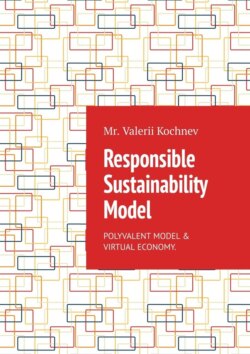Читать книгу Responsible Sustainability Model. Polyvalent model & Virtual economy - - Страница 9
На сайте Литреса книга снята с продажи.
I. POLYVALENT MODEL & VIRTUAL ECONOMY
8. Polyvalent model. Essence. Characteristics
ОглавлениеIn the modern competitive environment, a number of issues are acute that relate to the safety and security of investments, communication and implementation of products of other similar projects in a single environment, as well as the demand and prospects for a wide range of applications in the material economy, growth and development forecasts, including in the stock market.
A platform for a variety of diversified industries can respond to such requests within its system as a polyvalent model for their interaction. The polyvalent model is a reaction to objectively prevailing conditions, which allows projects from different industries to successfully function together, as well as simultaneously develop further through the use of existing innovative technologies and new philosophical ideas in combination with each other. The purpose of the polyvalent model is to create a universal framework for facilitating the implementation of initiatives related to green and sustainable development through a series of large-scale projects aimed at developing green and sustainable sectors of the economy, and its main emphasis is on the integration of the social and economic spheres of the economy to create an environment in which the results of the development of components and applications will contribute to the formation of a positive attitude towards the environment, the development of various sustainable initiatives, the assessment of their environmental impact and the monetisation of these initiatives and materialise when used as a basis for bringing together people who share similar goals for development green sustainable development and community. The polyvalent model will provide many opportunities for implementing projects of various sizes and will include both small initiatives at the local level and large-scale projects at the global level.
Such a polyvalent model in the process of development generates new directions within itself, attracts third-party opportunities, responds to new challenges as they arise, may involve the use of cross-technologies, the development of joint algorithms that are effectively implemented in the external environment, building interactions with third-party innovative projects, in different degrees of integration, as well as other advantages for achieving sustainable development goals.
It is important to note that the polyvalent model has the following characteristics:
First point. Innovators (novelties) make up a large percentage.
Second step. Obviously, it is carried out in a variety of industries.
As a third. Synergy exists between several aspects and components.
Four. There are a number of different areas of development inside.
An important characteristic of the polyvalent model is the constant growth of complexity, as well as internal dynamics, including the evolution of existing components, the emergence of new ones, the creation of new relationships, the establishment of new directions for development. There is no doubt that the more complex the model, the more development options, the higher its efficiency, the more profitable it will be. A polyvalent model that takes into account all events that can be foreseen and affect future development creates an opportunity for growth and increased profits.
The polyvalent model is a wide variety of synergies (interconnections), which allows the use of components and components in several different segments, each of which has its own value.
The polyvalent model is characterised by a high level of novelty and flexibility, which contributes to the creation and development of new new applications, in which the variety of possible changes and combinations is comprehensive and qualitative, and a wide range of design changes and combinations can be identified.
